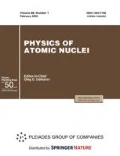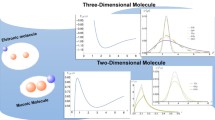Abstract
The results of an improved calculation of the rate of muon transfer from the 1s state of the muonic-hydrogen atom to neon at collision energies ranging between 10−4 and 15 eV are presented. The calculation in question is performed within the method of perturbed stationary states, where the wave function for the three-particle system formed by a muon, a proton, and a neon nucleus is constructed in the form of an expansion in eigenfunctions of the two-center Coulomb problem formulated in terms of Jacobi coordinates for the entrance reaction channel. This approach makes it possible to obtain an asymptotically correct description of the entrance channel at a low collision energy: one obtains a correct dissociation limit, spurious long-range potentials are absent, and a polarization attraction between a muonic-hydrogen atom and a neon atom appears in a natural way. Moreover, one can readily take into account electron screening, which is of importance at low collision energies. All flaws in the description come into play only in the muon-transfer channel, where one does not expect that their effect is significant because of high energies of divergence of reaction products. The calculation performed within this scheme previously permitted explaining special features observed experimentally in the behavior of the muon-transfer rate as a function of temperature of the hydrogen-neon mixture being considered. In the present study, a more refined algorithm for constructing basis functions in the two-center Coulomb problem was used, whereby agreement between the calculated values of the muon-transfer rate and experimental data was improved.
Similar content being viewed by others
References
L. Schellenberg, Muon Cat. Fusion 5–6, 73 (1990–91).
R. Jacot-Guillarmod, Phys. Rev. A 51, 2179 (1995).
Yu. S. Sayasov, Helv. Phys. Acta 63, 547 (1990).
S. V. Romanov, Eur. Phys. J. D 28, 11 (2004).
A. Dupays, Phys. Rev. Lett. 93, 043401 (2004).
S. S. Gershtein, Sov. Phys. JETP 16, 501 (1962).
R. Pohl et al., Nature 466, 213 (2010).
D. Taqqu, Preprint No. 95-07, PSI (Villigen, 1995).
R. Pohl et al., Hyperf. Interact. 119, 77 (1999).
A. A. Radzig and B. M. Smirnov, Reference data on Atoms, Molecules and Ions (Springer, Heidelberg, 1985; Energoatomizdat, Moscow, 1986), p. 137.
S. I. Vinitsky and L. I. Ponomarev, Sov. J. Part. Nucl. 13, 557 (1982).
A. Dupays, B. Lepetit, J. A. Beswick, et al., Phys. Rev. A 69, 062501 (2004).
G. Fiorentini and G. Torelli, Nuovo Cimento A 36, 317 (1976).
K. Kobayashi, T. Ishihara, and N. Toshima, Muon Cat. Fusion 2, 191 (1988).
I. V. Komarov, L. I. Ponomarev, and S. Yu. Slavyanov, Spheroidal and Coulomb Spheroidal Functions (Nauka, Moscow, 1976), pp. 15–17, 171–178, 190–196 [in Russian].
D. I. Abramov, S. Yu. Ovchinnikov, and E. A. Solov’ev, Phys. Rev. A 42, 6366 (1990).
G. Jaffé, Z. Phys. 87, 535 (1934).
W. G. Baber and H. R. Hassé, Proc. Cambridge Philos. Soc. 31, 564 (1935).
D. R. Bates and T. R. Carson, Proc. R. Soc. London, Ser. A 234, 207 (1956).
G. Hadinger, M. Aubert-Frécon, and G. Hadinger, J. Phys. B 22, 697 (1989).
A. S. Davydov, Quantum Mechanics (Pergamon, 1965).
G. Holzwarth and H. J. Pfeiffer, Z. Phys. A 272, 311 (1975).
A. V. Kravtsov, A. I. Mikhailov, and N. P. Popov, J. Phys. B 19, 1323 (1986).
E. Clementi and C. Roetti, At. Data Nucl.Data Tables 14, 177 (1974).
Author information
Authors and Affiliations
Corresponding author
Additional information
Original Russian Text © S.V. Romanov, 2014, published in Yadernaya Fizika, 2014, Vol. 77, No. 1, pp. 3–14.
Rights and permissions
About this article
Cite this article
Romanov, S.V. Calculation of the rate of muon transfer from a proton to neon on the basis of the two-center coulomb basis. Phys. Atom. Nuclei 77, 1–12 (2014). https://doi.org/10.1134/S1063778813120144
Received:
Published:
Issue Date:
DOI: https://doi.org/10.1134/S1063778813120144




